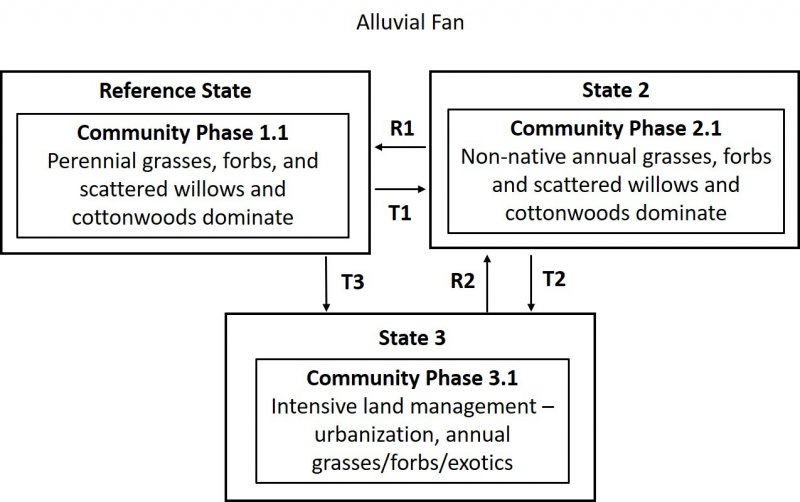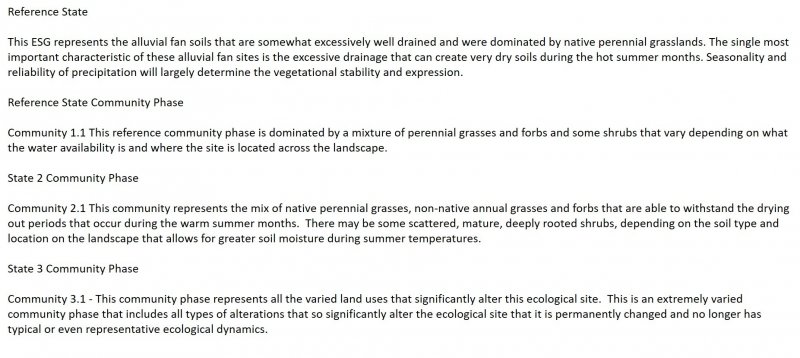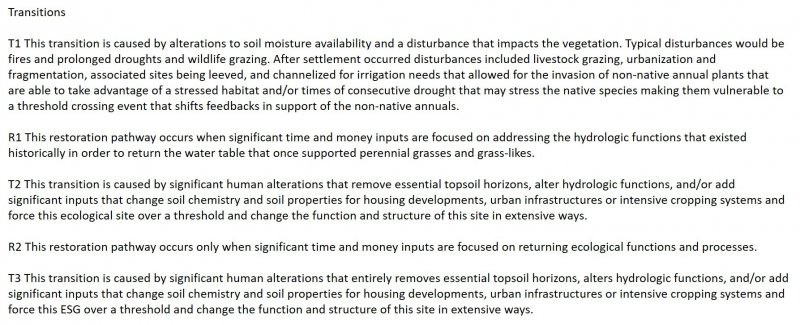Ecological site group R015XY007CAESG
Alluvial Fan
Last updated: 09/07/2023
Accessed: 12/22/2025
Ecological site group description
Key Characteristics
- located on alluvial fans
Provisional. A provisional ecological site description has undergone quality control and quality assurance review. It contains a working state and transition model and enough information to identify the ecological site.
Physiography
This ESG is typically found on alluvial fans that have slopes from 0 to 9 percent typically, and up to 30% in specific locations. Elevations typically range from 30 to 4000 feet.
Climate
The average annual precipitation in this area is typically 11 to 39 inches. Some areas can get as low as 6 inches, while the areas at higher elevations can reach up to 88 inches on average. Snowfall is common in the northern half of the part north of San Francisco and rare elsewhere. Precipitation is evenly distributed throughout fall, winter, and spring but is very low in summer. Coastal areas receive some moisture from fog in summer. Most of the rainfall occurs as low- or moderate-intensity, Pacific frontal storms during the period October to May. The average annual temperature is 52 to 65 degrees F (11 to 18 degrees C), decreasing from south to north. The freeze-free period averages 275 days and ranges from 180 to 365 days, decreasing in length with elevation and from south to north.
Soil features
Soils in this ESG consist mainly of deep and very deep, moderately well drained soils that formed in alluvial material from mixed rock sources.
The soils that represent this ESG include:
Esparto, a fine-loamy, mixed, superactive, thermic Typic Haploxeralfs
Kimberlina, a coarse-loamy, mixed, superactive, calcareous, thermic Typic Torriorthents
Snelling, a fine-loamy, mixed, superactive, thermic Typic Haploxeralfs
Vegetation dynamics
Ecological Narrative:
This ESG covers the thermic (warm) alluvial fans that receive less than 20 inches of precipitation each year in MLRA 15 that were at one time part of a vast complex of perennial native grasslands would have been most likely. The fragmented and urbanized landscape on these excessively drained alluvial soils within this MLRA that exists today makes it difficult to imagine the natural landscape prior to human development.
Annual Grassland habitat occurs mostly on flat plains to gently rolling foothills. Common soil orders include Entisols and Alfisols. Entisols are often found at lower elevations on flood plains and swales that receive periodic deposits of alluvium and are characterized by little or no pedogenic horizon development. Alfisols occur at higher elevations above the valley floor. Some Annual Grassland habitats can be found in the drier portion of the southern San Joaquin Valley on Aridisols. Climatic conditions are typically Mediterranean, with cool, wet winters and dry, hot summers. The length of the frost free season averages 250 to 300 days.
Annual Grassland habitats are open grasslands composed primarily of annual plant species. Many of these species also occur as understory plants in Valley Oak Woodland and other habitats. Structure in Annual Grassland depends largely on weather patterns and livestock grazing. Dramatic differences in physiognomy, both between seasons and between years, are characteristic of this habitat. Fall rains cause germination of annual plant seeds. Plants grow slowly during the cool winter months, remaining low in stature until spring, when temperatures increase and stimulate more rapid growth. Large amounts of standing dead plant material can be found during summer in years of abundant rainfall and light to moderate grazing pressure. Heavy spring grazing favors the growth of summer-annual forbs, such as tarweed and turkey mullein, and reduces the amount of standing dead material. On good sites, herbage yield may be as high as 4900 kg/ha (4400 lb/ac).
Introduced annual grasses are the dominant plant species in this habitat. These include wild oats, soft chess, ripgut brome, red brome, wild barley, and foxtail fescue. Common forbs include broadleaf filaree, redstem filaree, turkey mullein, true clovers, bur clover, popcorn flower, and many others. California poppy, the State flower, is found in this habitat. Perennial grasses, found in moist, lightly grazed, or relic prairie areas, include purple needlegrass and Idaho fescue. Vernal pools, found in small depressions with a hardpan soil layer, support downingia, meadowfoam, and other species. Species composition is also related to precipitation. Perennial grasses are more common on northern sites with mean annual rainfall greater than 150 cm (60 in). Soft chess and broadleaf filaree are common in areas with 65-100 cm (25-40 in) of rainfall, and red brome and redstem filaree are common on southern sites with less than 25 cm (10 in) of precipitation.
Annual Grassland habitats occupy what was once a pristine native grassland. The native grassland likely consisted of climax stands of perennial bunchgrasses, such as purple needlegrass, on wetter sites, with annual species existing as climax communities on drier alluvial plains. Today, plant succession in the classical sense does not occur in Annual Grassland habitats. However, species composition is greatly influenced by seasonal and annual fluctuations in weather patterns. Annual plants germinate with the first fall rains that exceed about 15 mm (0.6 in), growing slowly during winter and more rapidly in spring. Botanical composition changes throughout the growing season because of differences in plant phenology (Heady 1958). Most annuals mature between April and June, although some species, such as tarweed and turkey mullein, continue to grow into summer.
Fall rains that encourage germination, followed by an extended dry period, favor the growth of deep-rooted forbs, but continuing rainfall favors rapidly growing grasses. Livestock grazing favors the growth of low-stature, spring-maturing forbs, such as filaree, and summer annuals, such as turkey mullein. Because these are important food plants for many wildlife species, proper levels of livestock grazing are generally beneficial in this habitat. In the absence of livestock, Annual Grassland habitats are often dominated by tall, dense stands of grasses such as ripgut brome and wild oats. Although Annual Grassland habitats consist largely of non-native annuals, these effectively prevent the reestablishment of native perennials over large areas and now comprise climax communities. Introduced annuals should be considered naturalized plant species and so managed, rather than as invading species characteristic of poor range sites.
Information from:
California Wildlife Habitat Relationships System
California Department of Fish and Game
California Interagency Wildlife Task Group
John G. Kie
Major Land Resource Area
MLRA 015X
Central California Coast Range
Stage
Provisional
Contributors
Kendra Moseley
Darren Pinnegar
Click on box and path labels to scroll to the respective text.


